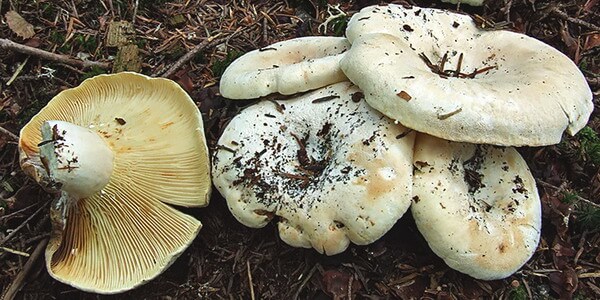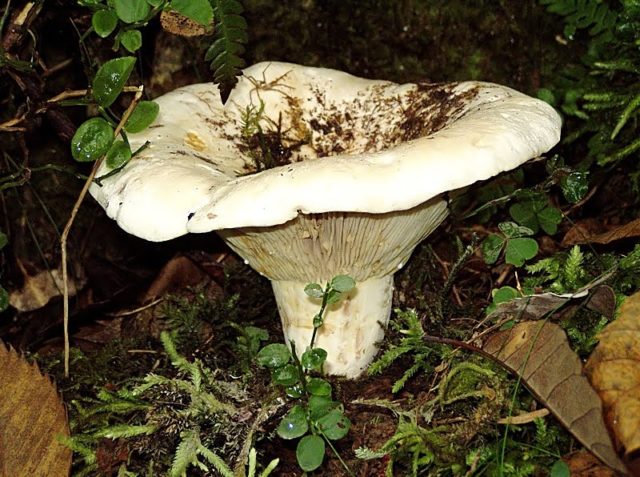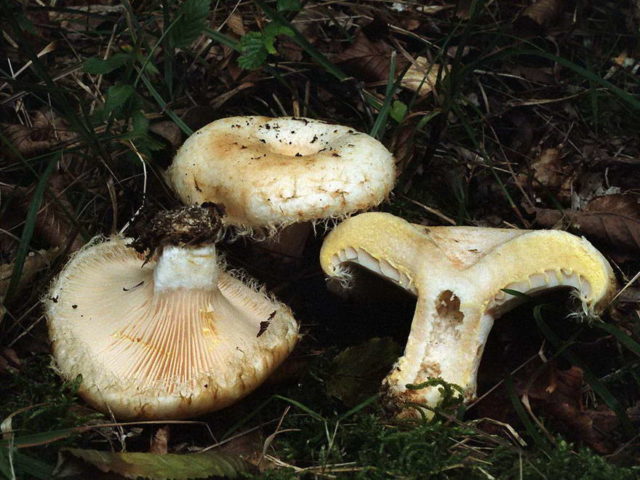Content
Squeaky mushrooms, or squeaks, violinists, are considered by many to be a variety of mushrooms, because of their incredible external similarity. However, representatives of milkmen are inferior to white milk mushrooms in taste, therefore, they are classified as conditionally edible. Despite this, avid mushroom pickers collect violinists for pickling, knowing about the mass of useful properties that have a beneficial effect on the body.
Where squeaky mushrooms grow
Squeak, or spurge, got its name from the squeak emitted when you touch the hat. The second name is given in connection with the very pungent, bitter juice released when the mushroom is cut. Violin mushrooms are very common fungi found everywhere. They are found throughout the territory of Russia - from its western part to the Far East. The culture prefers sunlit, open spaces in deciduous or mixed forests. Squeaky mushrooms like to settle under aspen or birch trees, which grow alone, on soil covered with dry foliage or moss. According to the description and photo, violin mushrooms grow in large groups, young with overripe individuals interspersed. The violin enters the stage of active growth in July and bears fruit until October.
What violin mushrooms look like
Squeaks are not referred to white, but to felt mushrooms, which grow to very large sizes, with a cap diameter of about 16 - 17 cm.At a young age, violinists have a convex white cap, but during growth it gradually straightens and acquires a yellowish tint. Adults are distinguished by a dense and fleshy cap, funnel-shaped with wavy edges. Hard, brittle pulp, when broken, gives off a milky white juice, which is characteristic of all representatives of the lactarius. The same firm, white leg no more than 6 cm long is narrowed closer to the base. Its entire surface is covered with a white, delicate fluff, for which the squeaky mushroom was named the felt mushroom.
Is it possible to eat squeaky mushrooms
The violin mushroom is edible, although it is much inferior in taste to the white milk mushroom. More precisely, it belongs to the conditionally edible mushroom category, which requires mandatory pre-processing of the product before eating it.
Important conditions for the preparation of this variety are:
- soaking in cold water for 3 - 4 days, with a constant change of water to fresh;
- soaking in hot water with a new one every few hours;
- boiling the squeaks for 30 minutes. or salting.
Only after thorough soaking does the violin lose the bitter, unpleasant aftertaste that the milky juice secretes.The hot method allows you to quickly eliminate it, but even after that, the mushrooms need heat treatment or salting, the process of which is at least 40 days.
Taste qualities of mushrooms
In taste and aroma, properly prepared salted squeaks vaguely resemble milk mushrooms. They are dense, strong and firm, which is quite popular with gourmets. However, many people consider them to be very mediocre in taste, so they bypass them in the forest. In the absence of other representatives of the mushroom kingdom, the violins can be safely placed in the basket in order to diversify the table in the winter and spring seasons.
Benefits and harm to the body
Like the white milk mushroom, the squeak mushroom contains a lot of useful substances. These include:
- vitamins and amino acids;
- cellulose;
- phosphorus, potassium, sodium and iron.
The daily human need for vital elements - phosphorus, iron and potassium - can be satisfied with the usual portion of the violin mushroom dish. Despite the low calorie content of squeak - only 23 kcal per 100 g of product, it gives a feeling of satiety and is the main supplier of protein when refusing meat or fish during a diet. Therefore, a product is considered dietary if the amount of salt when consumed is minimal.
The regular presence of violin on the menu helps to reduce blood sugar and cholesterol levels, and this has a beneficial effect on the work of the cardiovascular system. The fungus is considered a natural antibiotic that has an anti-inflammatory, bactericidal effect on the human body. It promotes the development of protective properties during bacterial and viral infections, helping a person to overcome the disease faster. As a result, the body's immune system is fully strengthened, its vitality rises, and the energy balance is restored. Alcohol tincture of violin is considered an excellent remedy against cancerous tumors, eliminating inflammatory processes of a different nature.
The squeak does not only benefit the human body. If abused, it can become malicious. Absolutely all mushrooms are heavy food that requires proper preparation. Otherwise, the risk of heaviness in the stomach, severe pain and cuts is not excluded. Therefore, it is very important to follow the technological process of cooking for the violin and not to abuse the product in the diet. This is especially true for children and the elderly. Squeak is also contraindicated for people with stomach diseases and problems with the gastrointestinal tract. These include primarily gastritis, an ulcer with low acidity of gastric juice.
Similar species
Skripuns belong to low category mushrooms, and therefore mushroom pickers do not specifically go after them. However, violinists often confuse mushrooms with white milk mushrooms, which can be clearly seen from the photo and description of the latter. However, upon closer examination, it is quite possible to distinguish between these two varieties:
- Milk mushrooms in the lower part of the cap have a characteristic fringe, which the squeak does not have.
- The excreted milky juice in the air at the breast becomes yellow after a while, and the color of the liquid does not change in the violinist.
- Squeaky has greater strength and rigidity.
- At the load, the plates under the cap are white, and at the squeak, they are light yellow.
Both mushrooms - milk mushroom and squeaky - are edible, so there is no threat of poisoning if one is replaced by another. But, the characteristic differences between the white milk mushroom and the violin will allow the attentive mushroom picker to properly prepare each type, which will reveal all the gastronomic qualities of the product and dishes made from it.
Collection rules
Squeaky mushrooms are harvested in autumn - from the beginning of September to the end of the month. You need to look for them in birch groves in lighted, open places, soil covered with a dense grass layer or moss.Squeaks grow in large groups almost everywhere, which makes finding them fairly easy and quick.
Having found a group of squeaky mushrooms of different ages, young individuals are selected, the cap of which is still convex, with a diameter of up to 5 - 7 cm. They are cut off with a sharp knife, almost under the cap, since the leg still does not go into food. They put the cut squeaks in a basket or basket with the caps down, which eliminates the risk of breaking off and damage during transportation. Squeaks are large, overgrown, with a cap more than 10 cm in diameter, not harvested.
A useful video on how violins grow will help you not to make a mistake in choosing mushrooms:
Use
In Russia, the violin belongs to the low, fourth, category of mushrooms, and in the West it is considered inedible at all. Squeak is consumed only in salted and fermented form, after having subjected it to the soaking process. The mushrooms brought from the forest are cleaned of debris, washed and cut off the legs under the base of the cap. Even after proper salting, the squeaks retain a rather mediocre taste with a slightly sour aroma, characteristic of salted lamellar mushrooms.
However, they bring tangible benefits to the human body due to their unique composition and active active ingredients that have a beneficial effect on the work of vital organs. With the help of salted and fermented squeaks, you can significantly diversify the winter-spring diet. Salted spurge retains its white color, with a slight bluish tinge, remaining strong, hard, slightly creaking on the teeth. It smells like a real weight. These mushrooms are not eaten boiled, stewed, or fried.
Conclusion
Squeaky mushrooms are much inferior to white milk mushrooms, but this variety also has its admirers. The massive growth of the species in large numbers allows fans of "quiet hunting" to always return home with full baskets.











